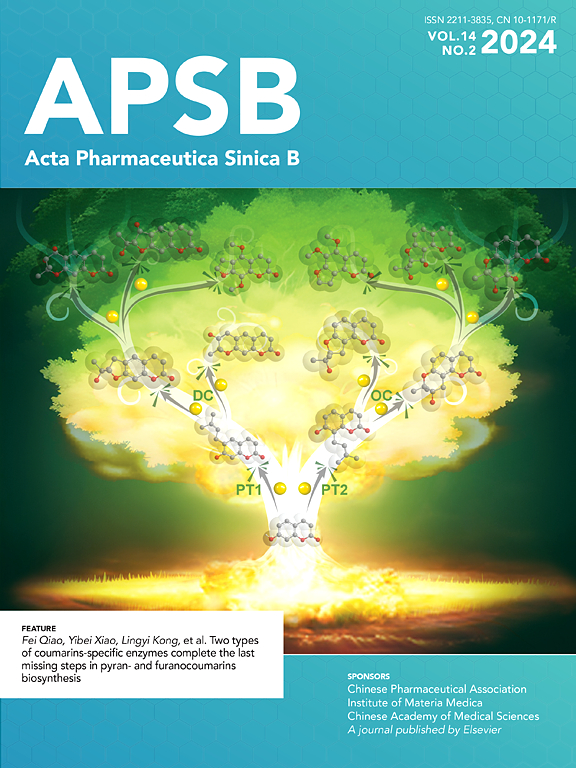A preclinical and first-in-human study of superstable homogeneous radiolipiodol for revolutionizing interventional diagnosis and treatment of hepatocellular carcinoma
IF 14.6
1区 医学
Q1 PHARMACOLOGY & PHARMACY
引用次数: 0
Abstract
Transarterial radioembolization (TARE) is a widely utilized therapeutic approach for hepatocellular carcinoma (HCC), however, the clinical implementation is constrained by the stringent preparation conditions of radioembolization agents. Herein, we incorporated the superstable homogeneous iodinated formulation technology (SHIFT), simultaneously utilizing an enhanced solvent form in a carbon dioxide supercritical fluid environment, to encapsulate radionuclides (such as 131I,177Lu, or 18F) with lipiodol for the preparation of radiolipiodol. The resulting radiolipiodol exhibited exceptional stability and ultra-high labeling efficiency (≥99%) and displayed notable intratumoral radionuclide retention and in vivo stability more than 2 weeks following locoregional injection in subcutaneous tumors in mice and orthotopic liver tumors in rats and rabbits. Given these encouraging findings, 18F was authorized as a radiotracer in radiolipiodol for clinical trials in HCC patients, and showed a favorable tumor accumulation, with a tumor-to-liver uptake ratio of ≥50 and minimal radionuclide leakage, confirming the feasibility of SHIFT for TARE applications. In the context of transforming from preclinical to clinical screening, the preparation of radiolipiodol by SHIFT represents an innovative physical strategy for radionuclide encapsulation. Hence, this work offers a reliable and efficient approach for TARE in HCC, showing considerable promise for clinical application (ChiCTR2400087731).

超稳定均质放射性脂醇用于革新肝细胞癌介入诊断和治疗的临床前和首次人体研究
经动脉放射栓塞(TARE)是一种广泛应用于肝细胞癌(HCC)的治疗方法,但由于放射栓塞剂制备条件严格,其临床应用受到限制。在此,我们结合了超稳定均相碘化配方技术(SHIFT),同时在二氧化碳超临界流体环境中利用增强溶剂形式,将放射性核素(如131I,177Lu或18F)与脂醇包封,以制备放射性脂醇。在小鼠皮下肿瘤和大鼠和家兔原位肝肿瘤中局部注射后,所制备的放射性脂醇具有优异的稳定性和超高的标记效率(≥99%),并在瘤内表现出显著的放射性核素保留和体内稳定性。鉴于这些令人鼓舞的发现,18F被授权作为放射性脂醇的放射性示踪剂用于HCC患者的临床试验,并显示出有利的肿瘤积累,肿瘤-肝脏摄取比≥50,放射性核素泄漏最小,证实了SHIFT用于TARE应用的可行性。在从临床前筛查向临床筛查转变的背景下,通过SHIFT制备放射性脂醇代表了一种创新的放射性核素包埋物理策略。因此,这项工作为肝癌TARE治疗提供了一种可靠、有效的方法,显示出相当大的临床应用前景(ChiCTR2400087731)。
本文章由计算机程序翻译,如有差异,请以英文原文为准。
求助全文
约1分钟内获得全文
求助全文
来源期刊

Acta Pharmaceutica Sinica. B
Pharmacology, Toxicology and Pharmaceutics-General Pharmacology, Toxicology and Pharmaceutics
CiteScore
22.40
自引率
5.50%
发文量
1051
审稿时长
19 weeks
期刊介绍:
The Journal of the Institute of Materia Medica, Chinese Academy of Medical Sciences, and the Chinese Pharmaceutical Association oversees the peer review process for Acta Pharmaceutica Sinica. B (APSB).
Published monthly in English, APSB is dedicated to disseminating significant original research articles, rapid communications, and high-quality reviews that highlight recent advances across various pharmaceutical sciences domains. These encompass pharmacology, pharmaceutics, medicinal chemistry, natural products, pharmacognosy, pharmaceutical analysis, and pharmacokinetics.
A part of the Acta Pharmaceutica Sinica series, established in 1953 and indexed in prominent databases like Chemical Abstracts, Index Medicus, SciFinder Scholar, Biological Abstracts, International Pharmaceutical Abstracts, Cambridge Scientific Abstracts, and Current Bibliography on Science and Technology, APSB is sponsored by the Institute of Materia Medica, Chinese Academy of Medical Sciences, and the Chinese Pharmaceutical Association. Its production and hosting are facilitated by Elsevier B.V. This collaborative effort ensures APSB's commitment to delivering valuable contributions to the pharmaceutical sciences community.
 求助内容:
求助内容: 应助结果提醒方式:
应助结果提醒方式:


